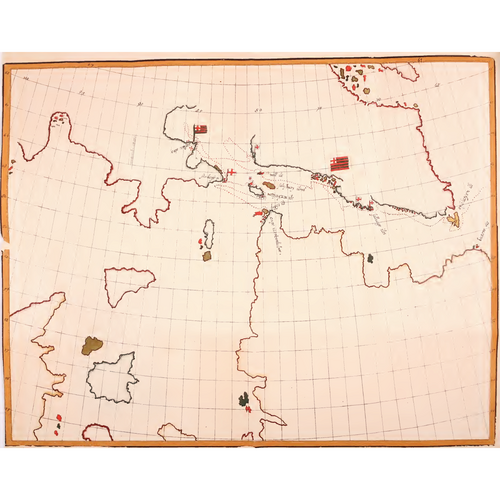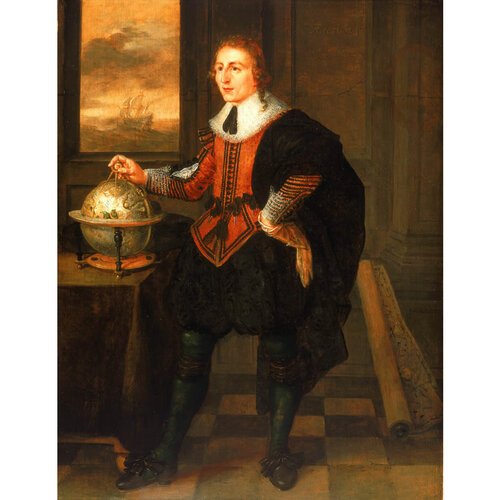
Source: Courtesy of Wikimedia Commons
BAFFIN, WILLIAM, arctic explorer; b. 1584?; d. 1622.
As with many of the early explorers and navigators, little is known of the life of William Baffin until the voyages upon which his reputation rests. The 11th edition of the Encyclopaedia Britannica gives 1584 as the year of his birth but does not supply the source of that important date. He was probably a native of London or vicinity and a self-educated man of humble origin but great talent, for Purchas speaks of him as “that learned-unlearned Mariner and Mathematician who, wanting art of words, so really employed himself to those industries, whereof here you see so evident fruits.”
In 1612 Baffin was chief pilot with Capt. James Hall’s ship Patience on the expedition when that unfortunate mariner was slain by revengeful Eskimos on the coast of Greenland. The Patience accompanied by the Heart’s Ease sailed from the Humber on 22 April and returned to Hull, 11 September under the command of Andrew Barker. Baffin kept a journal, printed in part in Purchas, beginning 8 July to the end of the voyage. In this account we get the first of his many and important astronomical observations. He also describes the Greenland Eskimos and their country, and tells of Hall’s tragic end.
When Baffin returned from this voyage he took service with the Muscovy Company which was trading with Russia and sending whalers to the Spitzbergen region. In 1613 the Company sent a fleet of seven vessels to the whaling grounds, and again the chief pilot was William Baffin, sailing on the Tiger under Capt. Benjamin Joseph. He sailed again with Capt. Joseph on a similar Spitzbergen voyage in 1614 on the Thomasine with a fleet of 11 ships and 2 pinnaces. Ice conditions extended well south making it a difficult season for northern navigation, but nevertheless Baffin explored a considerable section of the Spitzbergen coast returning to London 4 Oct. 1614.
Baffin’s fourth adventure was in the service of the Northwest Company to search for the northwest passage. This voyage was a continuation of three previous expeditions, under Henry Hudson (1610–11), who was abandoned by his men after wintering in Hudson Bay; Thomas Button, who wintered near Churchill (1612–13); and William Gibbons, who holed up on the Labrador coast (1614). The stout ship Discovery, used by all three of the previous expeditions, was fitted out under the command of Robert Bylot and Baffin again sailed as pilot on 15 March 1614/15. On 26 April, Baffin by observing an occultation of a star by the moon obtained the first longitude ever figured at sea while under way. Hudson Strait and the western end of Southampton Island were carefully examined, with particular attention given to the tides. The great 19th-century explorer, W. E. Parry*, checked Baffin’s observations over two hundred years later and found them very nearly correct. Baffin kept a full journal of this expedition which is accompanied by the only surviving example of one of his maps. The expedition abandoned its search for the northwest passage because of ice conditions at a place where land showed to the northeast; Parry later named the land Baffin Island “out of respect to the memory of that able and enterprising navigator.” The expedition returned in the fall of 1615. On his return from this voyage, Baffin concluded, quite correctly, that no navigable passage to the west existed out of Hudson Bay.
Baffin’s fifth and most important voyage was also undertaken in the Discovery with Bylot as captain. Leaving Gravesend, 26 March 1616, they passed John Davis’s farthest north at Hope Sanderson on the Greenland coast and continued for another 300 miles to 77º45´ which remained the farthest north reached for 236 years. They then sailed around and mapped the entire shore of “Baffin’s Bay,” including the entrances of “Sir Thomas Smith’s,” “Alderman Jones,” and “Sir James Lancaster’s” sounds. Lancaster Sound was not recognized, however, as the entrance to the sought-after northwest passage. It is an ironic historical fact that Baffin’s greatest discovery, at first accepted, gradually became suspect and was reduced and finally eliminated from maps until rediscovered and confirmed by Sir John Ross* on his first expedition in 18l8. Baffin’s papers and map relating to Baffin Bay were given to Purchas, who suppressed them with exasperating casualness.
Baffin is certainly the most proficient navigator and observer of all the arctic explorers of his period. Following his return from the discovery of Baffin Bay, but without finding the northwest passage, he decided to seek that elusive waterway from the western end if he could find employment that would take him to the Pacific. The opportunity came in 1617 and he sailed 4 February as master’s mate on the Anne Royal in the fleet of Capt. Martin Pring for the East India Company. The fleet arrived at Saldanha Bay 21 June and at Surat in September. The Anne Royal was detached and sent to Mocha and visited other ports in the Red Sea and the Persian Gulf area, where Baffin worked steadily, surveying and charting. In September 1619 the Anne Royal was back in the Thames. Baffin had not been anywhere near the northwestern coast of North America but he was commended for his charts of Persia and the Red Sea.
The following year Baffin sailed again for the East Indies in the London, flagship of the fleet under Capt. Andrew Shilling who had been captain of the Anne Royal. Leaving the Downs 25 March the fleet arrived at Swally Roads 9 November, and, hearing of a fleet of Portuguese and Dutch ships awaiting them, they went in search of the enemy. In the engagement which took place 28 December in the Gulf of Oman, Capt. Shilling received wounds from which he died on 6 Jan. 1620/21. A year later 20 Jan. 1621/22 the English fleet arrived off Ormuz to lay siege to the Portuguese. William Baffin was sent on shore 23 January to make observations on the height and distance of the castle wall to find the range, “But as he was about the same, he received a shot from the Castle into his belly, wherewith he gave three leaps, and died immediately.” And Purchas records: “In the Indies he dyed, in the late Ormus businesse, slaine in fight with a shot, as hee was trying his mathematicall projects and conclusions.”
Mrs Baffin, a “troublesome, impatient woman,” made claim against the East India Company for his wage and a large settlement. After three years of negotiations her claims were finally settled for £500.
Thus the only part of Baffin’s life of which we are certain is the final decade, 1612 to 1622. The vast majority of his observations, records, surveys, and maps has disappeared but enough has survived to show us that during this time he became the best astronomical observer among all the navigators of his day.
Purchas, Pilgrimes (1905–7), XIV 365–411. The voyages of William Baffin, 1612–1622, ed. C. R. Markham (Hakluyt Soc., 1st ser., LXIII, 1881). DNB. Dodge, Northwest by sea. Encyclopaedia Britannica (11th ed., 29v., incl. Index, Cambridge, 1910–11). Oleson, Early voyages, 167–68. W. E. Parry, Journal of a second voyage for the discovery of a north-west passage from the Atlantic to the Pacific; performed in the years 1821–22–23 in His Majesty’s ships Fury and Hecla (London, 1824). J. Ross, A voyage of discovery, made under the orders of the Admiralty, in His Majesty’s ships Isabella and Alexander for the purpose of exploring Baffin’s Bay, and inquiring into the probability of a north-west passage (London, 1819).
Cite This Article
Ernest S. Dodge, “BAFFIN, WILLIAM,” in Dictionary of Canadian Biography, vol. 1, University of Toronto/Université Laval, 2003–, accessed January 9, 2026, https://www.biographi.ca/en/bio/baffin_william_1E.html.
The citation above shows the format for footnotes and endnotes according to the Chicago manual of style (16th edition). Information to be used in other citation formats:
| Permalink: | https://www.biographi.ca/en/bio/baffin_william_1E.html |
| Author of Article: | Ernest S. Dodge |
| Title of Article: | BAFFIN, WILLIAM |
| Publication Name: | Dictionary of Canadian Biography, vol. 1 |
| Publisher: | University of Toronto/Université Laval |
| Year of publication: | 1966 |
| Year of revision: | 1979 |
| Access Date: | January 9, 2026 |





